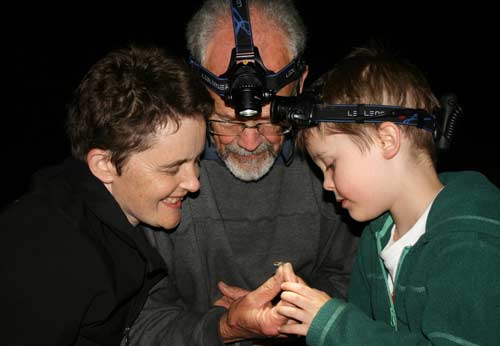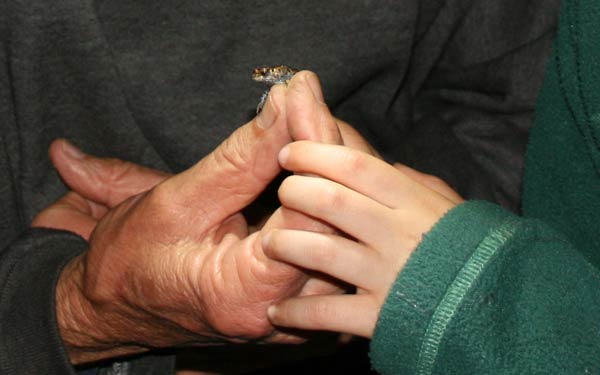Three Martins and a Toadlet
Science communicator Dr Jen Martin tells the story of her special family connection to the Martin's toadlet. Jen's story is an excerpt from Animals Make Us Human, a collection of essays from writers, photographers and researchers written in response to the 2019-20 bushfires. Proceeds go to the Australian Marine Conservation Society and Australian Wildlife Conservancy.
David Attenborough, Beyoncé, Mick Jagger, Marilyn Monroe, Nelson Mandela, John Cleese, Mozart, Greta Thunberg, the Dalai Lama and Rudyard Kipling.
What do these people have in common? They all have animal species named after them. And, for as long as I can remember, I’ve been deeply proud of the fact that my dad is among their ranks. I was in my final year of primary school when this recognition was bestowed upon him by his colleagues Margaret Davies and Murray Littlejohn. I vividly remember a conversation in which I tried to convince my school friends that having a ‘toadlet’ (a little grey and yellow frog) named after you was one of the coolest things that could ever happen.
I knew my dad had done a lot of frog-centred field research in exciting places when I was a kid (as evidenced by the postcards he sent my brothers and me), but at that age I don’t think I really understood much of what he was doing, or why. Perhaps having a frog named after him signalled to my young self that what he had been doing was both important and valued.
It wasn’t until many years later, when I was an undergraduate zoology student, that I thought again about the frog. I found out where it lived and the fact that it was one of very few toadlets to have teeth. I was delighted to discover that the only sure-fire way to tell Martin’s toadlet and the closely related Tyler’s toadlet apart is by their calls. This seemed fitting, given my dad’s close friendship with fellow herpetologist Mike Tyler. It also became clear to me there was a lot we didn’t know about Martin’s toadlet and that, due to land clearing and drought, its ongoing survival was looking quite uncertain.
I remember asking Dad (who by this time had retired) about the toadlet and discovering that, among the dozens of frog species he’d researched over many years, he had no clear memory of ever meeting ‘his’ frog. At that point I started hatching a plan to remedy the situation: it seemed essential to me that he should have the opportunity to hold a Martin’s toadlet in his hands. But amid a PhD, a busy academic job, marriage and children, I never got around to acting on my impulse.
It took the death, almost twenty years later, of Patsy Littlejohn, Dad’s colleague Murray Littlejohn’s wife, who was a combined surrogate grandmother and aunt to me, to underline just how precious time is. I didn’t want to wait any longer, so I started asking herpetologist friends for help, which revealed that the frog was now of great conservation concern. It had already disappeared from a number of previously consistent monitoring sites; if we were going to find Martin’s toadlet, we needed to do it soon.
On the warm, clear afternoon of 18 December 2013, we set off from Melbourne on a three-hour drive to East Gippsland. In the car I was joined by my dad, my then five-year-old son, Rohan, and Nick, a friend, colleague and expert herpetologist. Nearing our destination, we drove along a rough, dusty track and met up with another Rohan, a knowledgeable local ecologist who had identified a perfect spot for our search: an old dam in a stunning patch of forest.
We chatted and wandered as we waited for dusk to arrive. I didn’t doubt the expertise of my companions, but I did wonder about our chances of actually finding the frog. The summer had been dry and dusty and, as the sun set, my little dream seemed more and more like a very long shot.
Would it matter if we didn’t find one? I think my dad was moved by my passion for the quest, while the ecologists among us were well-accustomed to the disappointment of fruitless searches. My son was simply excited by the adventure with his beloved grandad and the pleasure of knowing that his little sister hadn’t been considered old enough to join us. But to me it mattered deeply: for twenty years I had pictured my dad holding ‘his’ frog and I wasn’t sure whether we would have another opportunity like this one if luck didn’t favour us this time.
I remember it being a beautiful, still evening, and – sure enough – frogs started calling as soon as darkness fell. It didn’t take long for us to recognise the calls of four different species: not including the one we wanted, but it was a promising start. I took my chatterbox son for a walk up the track under the still-pale sky, knowing that the herpetologists needed to be able to listen carefully. I can’t recall now what we whispered about, but I do remember my gratitude at being there with him. And I wondered what he would remember of the expedition in the years to come.
Barely any time had passed before I turned and saw three torch-beams being used to triangulate the location of a calling frog. Oh, the anticipation – had they really found a Martin’s toadlet? To my joy: yes! One, and only one, tiny grey and yellow toadlet had announced his presence with a characteristic second-long ‘aaaaaaaaaaaaaaaaaaarrr’.
In the years since, I have thought back to that night so many times – helped by the fact we have a picture on our wall from the evening, of my dad with my son and I on either side of him. We are all staring down at his hands and you have to look carefully to see the tiny frog he is gently holding. Each of us has a different expression on our face: my dad is clearly proud, I have a big grin, and my son, tenderly holding his grandfather’s hand, has a look of innocence and wonder that still brings tears to my eyes.

Of course, we released the frog immediately after we had photographed him, and he had already started calling again by the time we drove off into the starry night, all smiling. Martin’s toadlet is thought to be quite long-lived, so it’s conceivable that the same little frog is still around today, with no idea of the central role he played in making my dream come true.
I’m trying not to think about what the January 2020 bushfires might have meant for Martin’s toadlet – to be honest, I’ve been too afraid to ask. But I’ll never forget that night and the sense of quiet fulfilment and gratitude I felt and still feel today.
On the long drive home, just before dozing off, little Rohan (who is now taller than I am) said: ‘That’s one of the best things that’s ever happened to me.’ I couldn’t have said it better myself
Dr Jen Martin is an alum of multiple University of Melbourne programs, having completed a Bachelor of Arts/Science in 1998, a Bachelor of Science (Honours) in 2000, a PhD (Science) in 2006, and a Graduate Certificate in University Teaching in 2007.
Jen spent many years working as a field ecologist until she decided the most useful thing she could contribute as a scientist was to teach other scientists how to be effective and engaging communicators. Jen founded and leads the University of Melbourne’s acclaimed Science Communication Teaching Program.
Jen also practices what she preaches: she’s been talking about science each week on 3RRR radio for fifteen years, writes for a variety of publications, MCs events and was named the Unsung Hero of Australian Science Communication for 2019.
Jen's father, Dr Angus Martin, was the Head of the University of Melbourne School of Zoology and is now an Honorary staff member in the School of BioSciences. He received his PhD from the Faculty of Science in 1968.